Bridge Construction Project Plan
VerifiedAdded on 2020/04/07
|17
|4406
|225
AI Summary
This assignment details a comprehensive project plan for constructing a bridge. It outlines distinct stages (Stage 1 & Stage 2) with specific timelines and milestones, including safety approach testing, site plan finalization, supplier contracting, quality assurance agreements, and site development. The emphasis is on tracking progress, managing finances, and ensuring the construction firm delivers high-quality output. Monthly projections and achieved targets are key performance indicators for project success.
Contribute Materials
Your contribution can guide someone’s learning journey. Share your
documents today.

Statement of Work
for Pyrmont Swing Bridge Replacement and Construction
in Sydney, Australia
Project Overview
This AUD $31,474,000.00 project will involve the replacement and construction of the Pyrmont
Bridge, a swing-type bridge, which serves as the main transport route between the city and
Sydney's growing western suburbs while the swing span grants access to Darling Harbour for
large container ships. The scope of the project will include work on and over the Cockle Bay and
Darling Harbour. The project will consist of superstructure replacement, improvement and
replacement of the swing span, substructure modifications, complete mechanical and electrical
overhaul, operator house replacement and fender system replacement.
The 369 metres swing span bridge will be constructed and manufactured off-site and will float
into place once the foundations are laid in and ready to receive it. The construction phase will
comprise of mobilisation, demolishing of the existing bridge, traffic control management, laying
the foundation inland and water, deck construction, installation of machinery and electrical work,
overseeing the construction and manufacturing of the new swing span bridge at an off-site spot.
A comprehensive bridge inspection will be done upon the completion of the project. One of the
main goals of this project is to try to meet the 85 days deadline, ensure the safety of the workers
and the public while the construction is ongoing and how to control the cost while sustaining a
fast-track schedule on the project.
Client
Sydney Harbour Foreshore Authority
Background
The Top-Notch Construction Services will undertake the design, construction, supply,
installation and testing of all the systems, equipment and facilities needed to deliver a complete,
safe and operational swing span bridge which include: superstructure replacement, swing span
replacement, substructure modifications, complete mechanical and electrical overhaul, operator
house replacement and fender system replacement.
The Top-Notch Construction Services is composed of 4 contractors namely, DotCom
Construction, PNJB Co., YEKO Solutions and PHL Construction. The lead design firm will be
YEKO Solutions, along with several subconsultants. Donut Engineering Group will serve as one
of the subconsultant to YEKO Solutions. DotCom Construction and PNJB Co. will be in-charge
for the management and technical issues to the project. And lastly, PHL construction will be in-
for Pyrmont Swing Bridge Replacement and Construction
in Sydney, Australia
Project Overview
This AUD $31,474,000.00 project will involve the replacement and construction of the Pyrmont
Bridge, a swing-type bridge, which serves as the main transport route between the city and
Sydney's growing western suburbs while the swing span grants access to Darling Harbour for
large container ships. The scope of the project will include work on and over the Cockle Bay and
Darling Harbour. The project will consist of superstructure replacement, improvement and
replacement of the swing span, substructure modifications, complete mechanical and electrical
overhaul, operator house replacement and fender system replacement.
The 369 metres swing span bridge will be constructed and manufactured off-site and will float
into place once the foundations are laid in and ready to receive it. The construction phase will
comprise of mobilisation, demolishing of the existing bridge, traffic control management, laying
the foundation inland and water, deck construction, installation of machinery and electrical work,
overseeing the construction and manufacturing of the new swing span bridge at an off-site spot.
A comprehensive bridge inspection will be done upon the completion of the project. One of the
main goals of this project is to try to meet the 85 days deadline, ensure the safety of the workers
and the public while the construction is ongoing and how to control the cost while sustaining a
fast-track schedule on the project.
Client
Sydney Harbour Foreshore Authority
Background
The Top-Notch Construction Services will undertake the design, construction, supply,
installation and testing of all the systems, equipment and facilities needed to deliver a complete,
safe and operational swing span bridge which include: superstructure replacement, swing span
replacement, substructure modifications, complete mechanical and electrical overhaul, operator
house replacement and fender system replacement.
The Top-Notch Construction Services is composed of 4 contractors namely, DotCom
Construction, PNJB Co., YEKO Solutions and PHL Construction. The lead design firm will be
YEKO Solutions, along with several subconsultants. Donut Engineering Group will serve as one
of the subconsultant to YEKO Solutions. DotCom Construction and PNJB Co. will be in-charge
for the management and technical issues to the project. And lastly, PHL construction will be in-
Secure Best Marks with AI Grader
Need help grading? Try our AI Grader for instant feedback on your assignments.

charge to provide additional support with regards to design issues and communicating with the
design team. The project will start on 11/09/2017 and the target finish date will be 05/12/2017
with a total budget of AUD $31,474,000.00 (Free-management-ebooks, 2015).
Project Objective
To modernise and replace the ageing timber bridge with a concrete, steel and iron bridge
structure (Edo, 2012)
To reduce the cost of maintenance and inspection caused by the ageing structure.
To address structural apprehensions linked to the century-old underlying timber relieving
platform
To provide a valued link for residents and tourists to access public transport links and
local attractions particularly Darling Harbour.
To enhance business access and opportunities by connecting the city with Pyrmont and
Ultimo (Passenheim, 2012)
Major Deliverables
Statement of Work
Work Break Down Structure
Milestone schedule
Cost estimates
Quality Assurance/Safety Standards
Procurement Strategy (Bakouros & Kelessidis, 2012)
Customer Requirements
Complete the project with AUD $31,474,000.00 budget
Complete the project within 85 days
Superstructure replacement
Swing span replacement
Substructure modifications
Complete mechanical and electrical overhaul
Operator house replacement
Fender system replacement (UC Davis, 2013)
Work Breakdown Structure
design team. The project will start on 11/09/2017 and the target finish date will be 05/12/2017
with a total budget of AUD $31,474,000.00 (Free-management-ebooks, 2015).
Project Objective
To modernise and replace the ageing timber bridge with a concrete, steel and iron bridge
structure (Edo, 2012)
To reduce the cost of maintenance and inspection caused by the ageing structure.
To address structural apprehensions linked to the century-old underlying timber relieving
platform
To provide a valued link for residents and tourists to access public transport links and
local attractions particularly Darling Harbour.
To enhance business access and opportunities by connecting the city with Pyrmont and
Ultimo (Passenheim, 2012)
Major Deliverables
Statement of Work
Work Break Down Structure
Milestone schedule
Cost estimates
Quality Assurance/Safety Standards
Procurement Strategy (Bakouros & Kelessidis, 2012)
Customer Requirements
Complete the project with AUD $31,474,000.00 budget
Complete the project within 85 days
Superstructure replacement
Swing span replacement
Substructure modifications
Complete mechanical and electrical overhaul
Operator house replacement
Fender system replacement (UC Davis, 2013)
Work Breakdown Structure
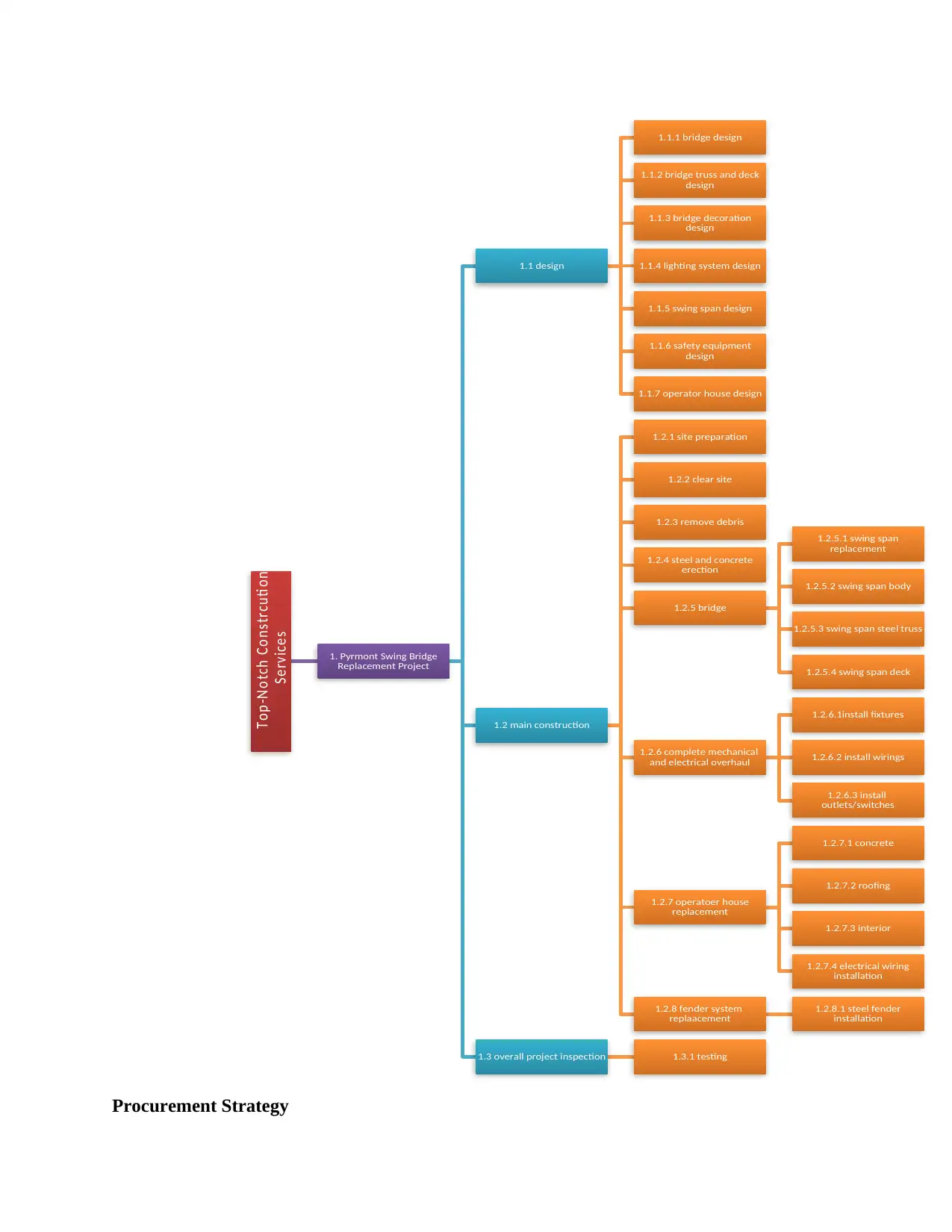
Procurement Strategy
Top-N otch Constrcuti on
Services
1. Pyrmont Swing Bridge
Replacement Project
1.1 design
1.1.1 bridge design
1.1.2 bridge truss and deck
design
1.1.3 bridge decoration
design
1.1.4 lighting system design
1.1.5 swing span design
1.1.6 safety equipment
design
1.1.7 operator house design
1.2 main construction
1.2.1 site preparation
1.2.2 clear site
1.2.3 remove debris
1.2.4 steel and concrete
erection
1.2.5 bridge
1.2.5.1 swing span
replacement
1.2.5.2 swing span body
1.2.5.3 swing span steel truss
1.2.5.4 swing span deck
1.2.6 complete mechanical
and electrical overhaul
1.2.6.1install fixtures
1.2.6.2 install wirings
1.2.6.3 install
outlets/switches
1.2.7 operatoer house
replacement
1.2.7.1 concrete
1.2.7.2 roofing
1.2.7.3 interior
1.2.7.4 electrical wiring
installation
1.2.8 fender system
replaacement
1.2.8.1 steel fender
installation
1.3 overall project inspection 1.3.1 testing
Top-N otch Constrcuti on
Services
1. Pyrmont Swing Bridge
Replacement Project
1.1 design
1.1.1 bridge design
1.1.2 bridge truss and deck
design
1.1.3 bridge decoration
design
1.1.4 lighting system design
1.1.5 swing span design
1.1.6 safety equipment
design
1.1.7 operator house design
1.2 main construction
1.2.1 site preparation
1.2.2 clear site
1.2.3 remove debris
1.2.4 steel and concrete
erection
1.2.5 bridge
1.2.5.1 swing span
replacement
1.2.5.2 swing span body
1.2.5.3 swing span steel truss
1.2.5.4 swing span deck
1.2.6 complete mechanical
and electrical overhaul
1.2.6.1install fixtures
1.2.6.2 install wirings
1.2.6.3 install
outlets/switches
1.2.7 operatoer house
replacement
1.2.7.1 concrete
1.2.7.2 roofing
1.2.7.3 interior
1.2.7.4 electrical wiring
installation
1.2.8 fender system
replaacement
1.2.8.1 steel fender
installation
1.3 overall project inspection 1.3.1 testing
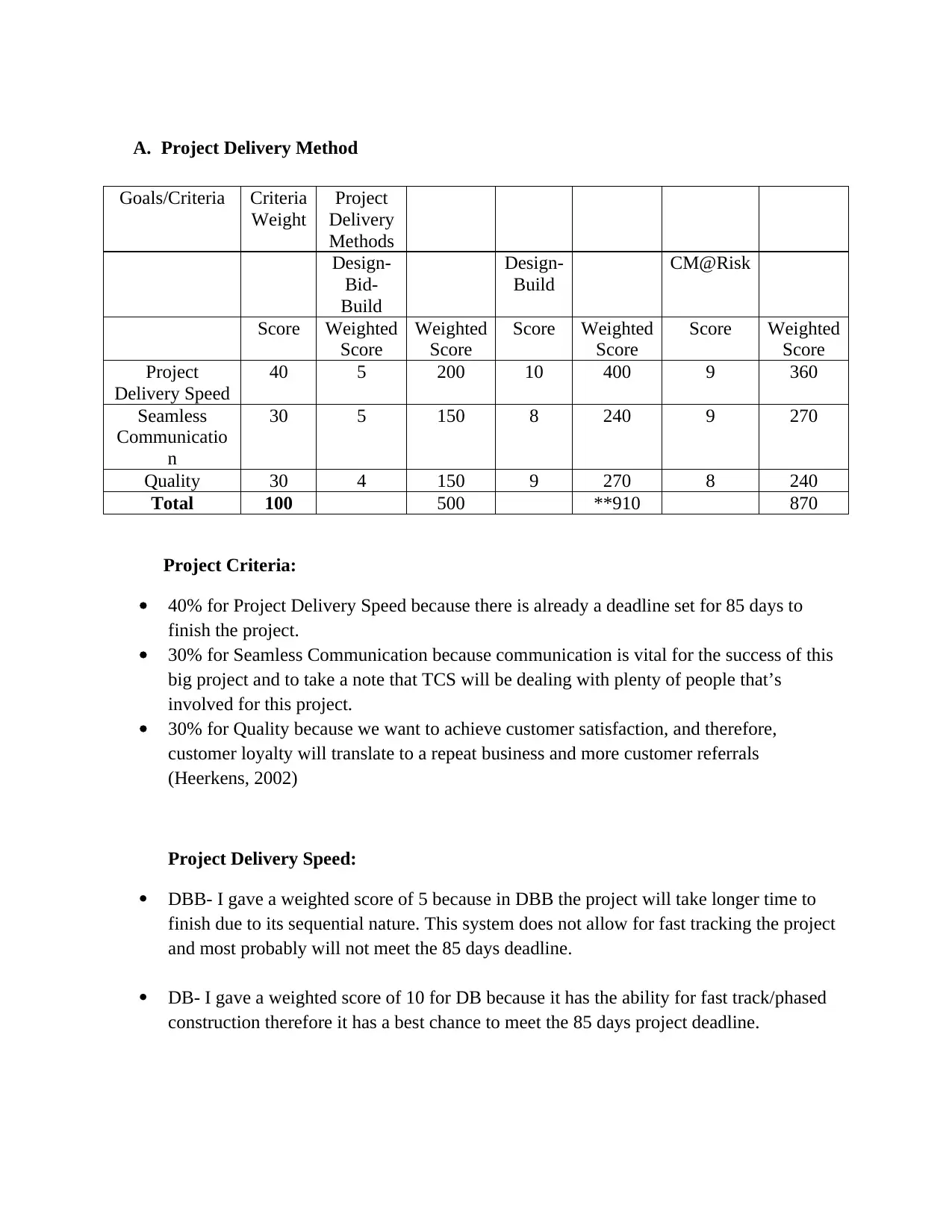
A. Project Delivery Method
Goals/Criteria Criteria
Weight
Project
Delivery
Methods
Design-
Bid-
Build
Design-
Build
CM@Risk
Score Weighted
Score
Weighted
Score
Score Weighted
Score
Score Weighted
Score
Project
Delivery Speed
40 5 200 10 400 9 360
Seamless
Communicatio
n
30 5 150 8 240 9 270
Quality 30 4 150 9 270 8 240
Total 100 500 **910 870
Project Criteria:
40% for Project Delivery Speed because there is already a deadline set for 85 days to
finish the project.
30% for Seamless Communication because communication is vital for the success of this
big project and to take a note that TCS will be dealing with plenty of people that’s
involved for this project.
30% for Quality because we want to achieve customer satisfaction, and therefore,
customer loyalty will translate to a repeat business and more customer referrals
(Heerkens, 2002)
Project Delivery Speed:
DBB- I gave a weighted score of 5 because in DBB the project will take longer time to
finish due to its sequential nature. This system does not allow for fast tracking the project
and most probably will not meet the 85 days deadline.
DB- I gave a weighted score of 10 for DB because it has the ability for fast track/phased
construction therefore it has a best chance to meet the 85 days project deadline.
Goals/Criteria Criteria
Weight
Project
Delivery
Methods
Design-
Bid-
Build
Design-
Build
CM@Risk
Score Weighted
Score
Weighted
Score
Score Weighted
Score
Score Weighted
Score
Project
Delivery Speed
40 5 200 10 400 9 360
Seamless
Communicatio
n
30 5 150 8 240 9 270
Quality 30 4 150 9 270 8 240
Total 100 500 **910 870
Project Criteria:
40% for Project Delivery Speed because there is already a deadline set for 85 days to
finish the project.
30% for Seamless Communication because communication is vital for the success of this
big project and to take a note that TCS will be dealing with plenty of people that’s
involved for this project.
30% for Quality because we want to achieve customer satisfaction, and therefore,
customer loyalty will translate to a repeat business and more customer referrals
(Heerkens, 2002)
Project Delivery Speed:
DBB- I gave a weighted score of 5 because in DBB the project will take longer time to
finish due to its sequential nature. This system does not allow for fast tracking the project
and most probably will not meet the 85 days deadline.
DB- I gave a weighted score of 10 for DB because it has the ability for fast track/phased
construction therefore it has a best chance to meet the 85 days project deadline.
Secure Best Marks with AI Grader
Need help grading? Try our AI Grader for instant feedback on your assignments.
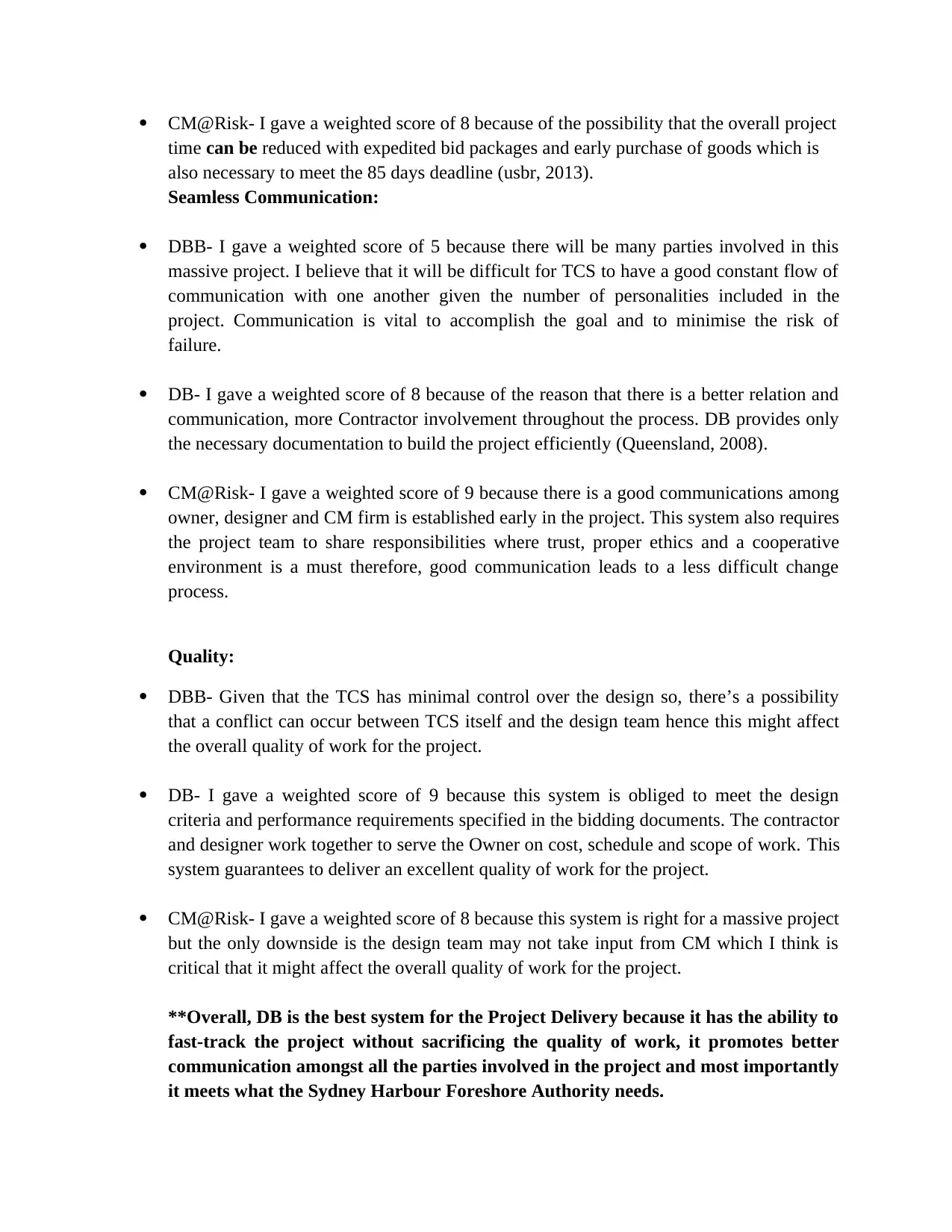
CM@Risk- I gave a weighted score of 8 because of the possibility that the overall project
time can be reduced with expedited bid packages and early purchase of goods which is
also necessary to meet the 85 days deadline (usbr, 2013).
Seamless Communication:
DBB- I gave a weighted score of 5 because there will be many parties involved in this
massive project. I believe that it will be difficult for TCS to have a good constant flow of
communication with one another given the number of personalities included in the
project. Communication is vital to accomplish the goal and to minimise the risk of
failure.
DB- I gave a weighted score of 8 because of the reason that there is a better relation and
communication, more Contractor involvement throughout the process. DB provides only
the necessary documentation to build the project efficiently (Queensland, 2008).
CM@Risk- I gave a weighted score of 9 because there is a good communications among
owner, designer and CM firm is established early in the project. This system also requires
the project team to share responsibilities where trust, proper ethics and a cooperative
environment is a must therefore, good communication leads to a less difficult change
process.
Quality:
DBB- Given that the TCS has minimal control over the design so, there’s a possibility
that a conflict can occur between TCS itself and the design team hence this might affect
the overall quality of work for the project.
DB- I gave a weighted score of 9 because this system is obliged to meet the design
criteria and performance requirements specified in the bidding documents. The contractor
and designer work together to serve the Owner on cost, schedule and scope of work. This
system guarantees to deliver an excellent quality of work for the project.
CM@Risk- I gave a weighted score of 8 because this system is right for a massive project
but the only downside is the design team may not take input from CM which I think is
critical that it might affect the overall quality of work for the project.
**Overall, DB is the best system for the Project Delivery because it has the ability to
fast-track the project without sacrificing the quality of work, it promotes better
communication amongst all the parties involved in the project and most importantly
it meets what the Sydney Harbour Foreshore Authority needs.
time can be reduced with expedited bid packages and early purchase of goods which is
also necessary to meet the 85 days deadline (usbr, 2013).
Seamless Communication:
DBB- I gave a weighted score of 5 because there will be many parties involved in this
massive project. I believe that it will be difficult for TCS to have a good constant flow of
communication with one another given the number of personalities included in the
project. Communication is vital to accomplish the goal and to minimise the risk of
failure.
DB- I gave a weighted score of 8 because of the reason that there is a better relation and
communication, more Contractor involvement throughout the process. DB provides only
the necessary documentation to build the project efficiently (Queensland, 2008).
CM@Risk- I gave a weighted score of 9 because there is a good communications among
owner, designer and CM firm is established early in the project. This system also requires
the project team to share responsibilities where trust, proper ethics and a cooperative
environment is a must therefore, good communication leads to a less difficult change
process.
Quality:
DBB- Given that the TCS has minimal control over the design so, there’s a possibility
that a conflict can occur between TCS itself and the design team hence this might affect
the overall quality of work for the project.
DB- I gave a weighted score of 9 because this system is obliged to meet the design
criteria and performance requirements specified in the bidding documents. The contractor
and designer work together to serve the Owner on cost, schedule and scope of work. This
system guarantees to deliver an excellent quality of work for the project.
CM@Risk- I gave a weighted score of 8 because this system is right for a massive project
but the only downside is the design team may not take input from CM which I think is
critical that it might affect the overall quality of work for the project.
**Overall, DB is the best system for the Project Delivery because it has the ability to
fast-track the project without sacrificing the quality of work, it promotes better
communication amongst all the parties involved in the project and most importantly
it meets what the Sydney Harbour Foreshore Authority needs.

B. Financial Contract Type
Goals/Criteria Criteria
Weight
Project
Delivery
Systems
Lump
Sum
GMP CPFF
Score Weighted
Score
Score Weighted
Score
Score Weighted
Score
Project
Delivery
Speed
40 5 200 6 240 8 320
Cost Control 30 4 120 8 240 4 120
Quality of
Work
30 4 120 7 210 4 120
Total 100 440 **690 560
Financial Criteria:
40% for Project Delivery Speed since there is already a set deadline of 85 days to
complete the project.
30% for Cost Control which is necessary to gain profit than lose money as there is
already a fixed budget of AUD $31,474,000.00 to complete the project.
30% for Quality of work because it will play a very important role on how to achieve
customer satisfaction, and therefore, customer loyalty will translate to a repeat business
and more customer referrals.
Project Delivery Speed:
Lump Sum- I gave a weighted score of 5 for Lump Sum. Although it can complete the
project on the specified date, it is not suited for project which requires a Design-Build
Delivery method and major bridge rehabilitation and replacement projects.
GMP- I gave a weighted score of 6 though it can able to fast-track a project, in case that
there will be changes to the design and scope; it may cause delays to the project.
Goals/Criteria Criteria
Weight
Project
Delivery
Systems
Lump
Sum
GMP CPFF
Score Weighted
Score
Score Weighted
Score
Score Weighted
Score
Project
Delivery
Speed
40 5 200 6 240 8 320
Cost Control 30 4 120 8 240 4 120
Quality of
Work
30 4 120 7 210 4 120
Total 100 440 **690 560
Financial Criteria:
40% for Project Delivery Speed since there is already a set deadline of 85 days to
complete the project.
30% for Cost Control which is necessary to gain profit than lose money as there is
already a fixed budget of AUD $31,474,000.00 to complete the project.
30% for Quality of work because it will play a very important role on how to achieve
customer satisfaction, and therefore, customer loyalty will translate to a repeat business
and more customer referrals.
Project Delivery Speed:
Lump Sum- I gave a weighted score of 5 for Lump Sum. Although it can complete the
project on the specified date, it is not suited for project which requires a Design-Build
Delivery method and major bridge rehabilitation and replacement projects.
GMP- I gave a weighted score of 6 though it can able to fast-track a project, in case that
there will be changes to the design and scope; it may cause delays to the project.
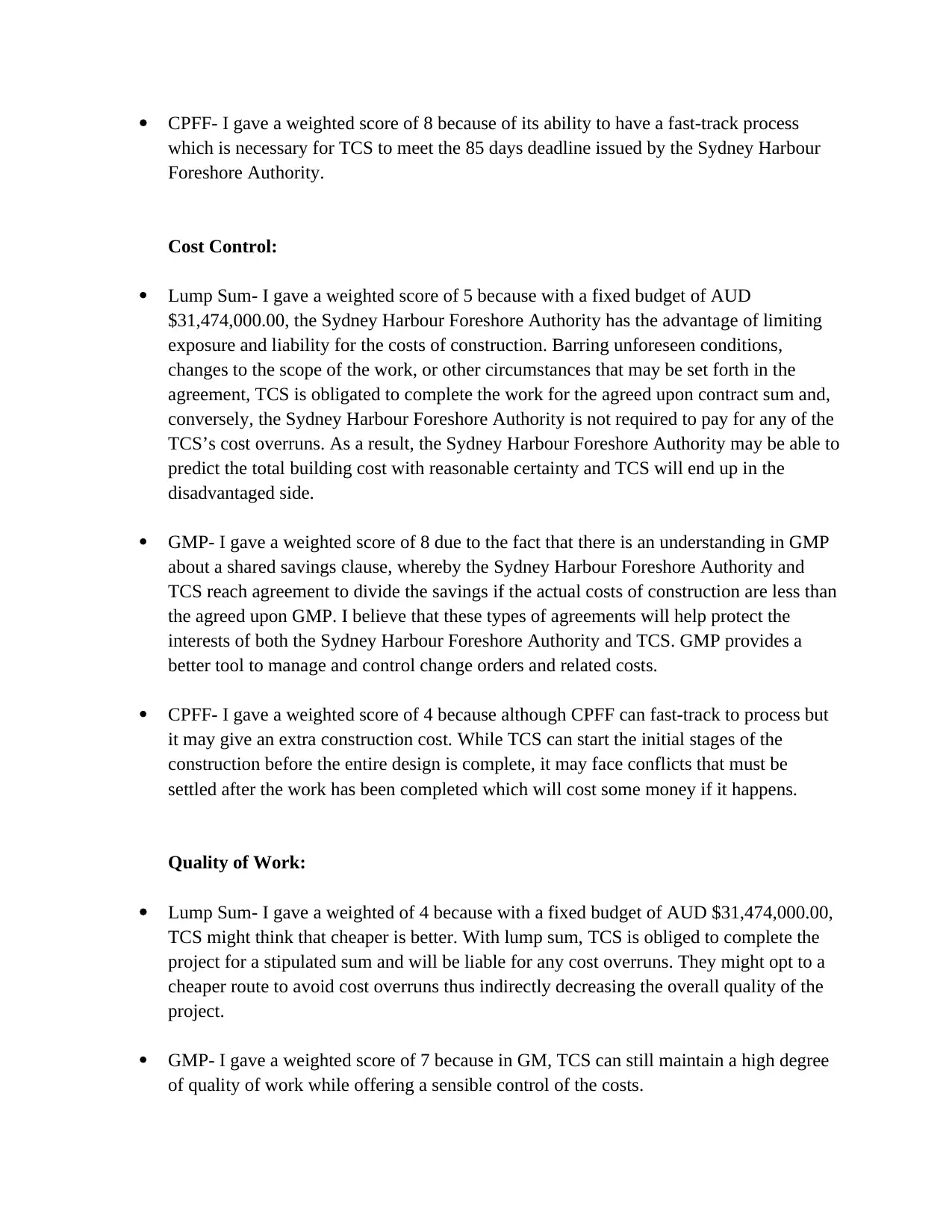
CPFF- I gave a weighted score of 8 because of its ability to have a fast-track process
which is necessary for TCS to meet the 85 days deadline issued by the Sydney Harbour
Foreshore Authority.
Cost Control:
Lump Sum- I gave a weighted score of 5 because with a fixed budget of AUD
$31,474,000.00, the Sydney Harbour Foreshore Authority has the advantage of limiting
exposure and liability for the costs of construction. Barring unforeseen conditions,
changes to the scope of the work, or other circumstances that may be set forth in the
agreement, TCS is obligated to complete the work for the agreed upon contract sum and,
conversely, the Sydney Harbour Foreshore Authority is not required to pay for any of the
TCS’s cost overruns. As a result, the Sydney Harbour Foreshore Authority may be able to
predict the total building cost with reasonable certainty and TCS will end up in the
disadvantaged side.
GMP- I gave a weighted score of 8 due to the fact that there is an understanding in GMP
about a shared savings clause, whereby the Sydney Harbour Foreshore Authority and
TCS reach agreement to divide the savings if the actual costs of construction are less than
the agreed upon GMP. I believe that these types of agreements will help protect the
interests of both the Sydney Harbour Foreshore Authority and TCS. GMP provides a
better tool to manage and control change orders and related costs.
CPFF- I gave a weighted score of 4 because although CPFF can fast-track to process but
it may give an extra construction cost. While TCS can start the initial stages of the
construction before the entire design is complete, it may face conflicts that must be
settled after the work has been completed which will cost some money if it happens.
Quality of Work:
Lump Sum- I gave a weighted of 4 because with a fixed budget of AUD $31,474,000.00,
TCS might think that cheaper is better. With lump sum, TCS is obliged to complete the
project for a stipulated sum and will be liable for any cost overruns. They might opt to a
cheaper route to avoid cost overruns thus indirectly decreasing the overall quality of the
project.
GMP- I gave a weighted score of 7 because in GM, TCS can still maintain a high degree
of quality of work while offering a sensible control of the costs.
which is necessary for TCS to meet the 85 days deadline issued by the Sydney Harbour
Foreshore Authority.
Cost Control:
Lump Sum- I gave a weighted score of 5 because with a fixed budget of AUD
$31,474,000.00, the Sydney Harbour Foreshore Authority has the advantage of limiting
exposure and liability for the costs of construction. Barring unforeseen conditions,
changes to the scope of the work, or other circumstances that may be set forth in the
agreement, TCS is obligated to complete the work for the agreed upon contract sum and,
conversely, the Sydney Harbour Foreshore Authority is not required to pay for any of the
TCS’s cost overruns. As a result, the Sydney Harbour Foreshore Authority may be able to
predict the total building cost with reasonable certainty and TCS will end up in the
disadvantaged side.
GMP- I gave a weighted score of 8 due to the fact that there is an understanding in GMP
about a shared savings clause, whereby the Sydney Harbour Foreshore Authority and
TCS reach agreement to divide the savings if the actual costs of construction are less than
the agreed upon GMP. I believe that these types of agreements will help protect the
interests of both the Sydney Harbour Foreshore Authority and TCS. GMP provides a
better tool to manage and control change orders and related costs.
CPFF- I gave a weighted score of 4 because although CPFF can fast-track to process but
it may give an extra construction cost. While TCS can start the initial stages of the
construction before the entire design is complete, it may face conflicts that must be
settled after the work has been completed which will cost some money if it happens.
Quality of Work:
Lump Sum- I gave a weighted of 4 because with a fixed budget of AUD $31,474,000.00,
TCS might think that cheaper is better. With lump sum, TCS is obliged to complete the
project for a stipulated sum and will be liable for any cost overruns. They might opt to a
cheaper route to avoid cost overruns thus indirectly decreasing the overall quality of the
project.
GMP- I gave a weighted score of 7 because in GM, TCS can still maintain a high degree
of quality of work while offering a sensible control of the costs.
Paraphrase This Document
Need a fresh take? Get an instant paraphrase of this document with our AI Paraphraser
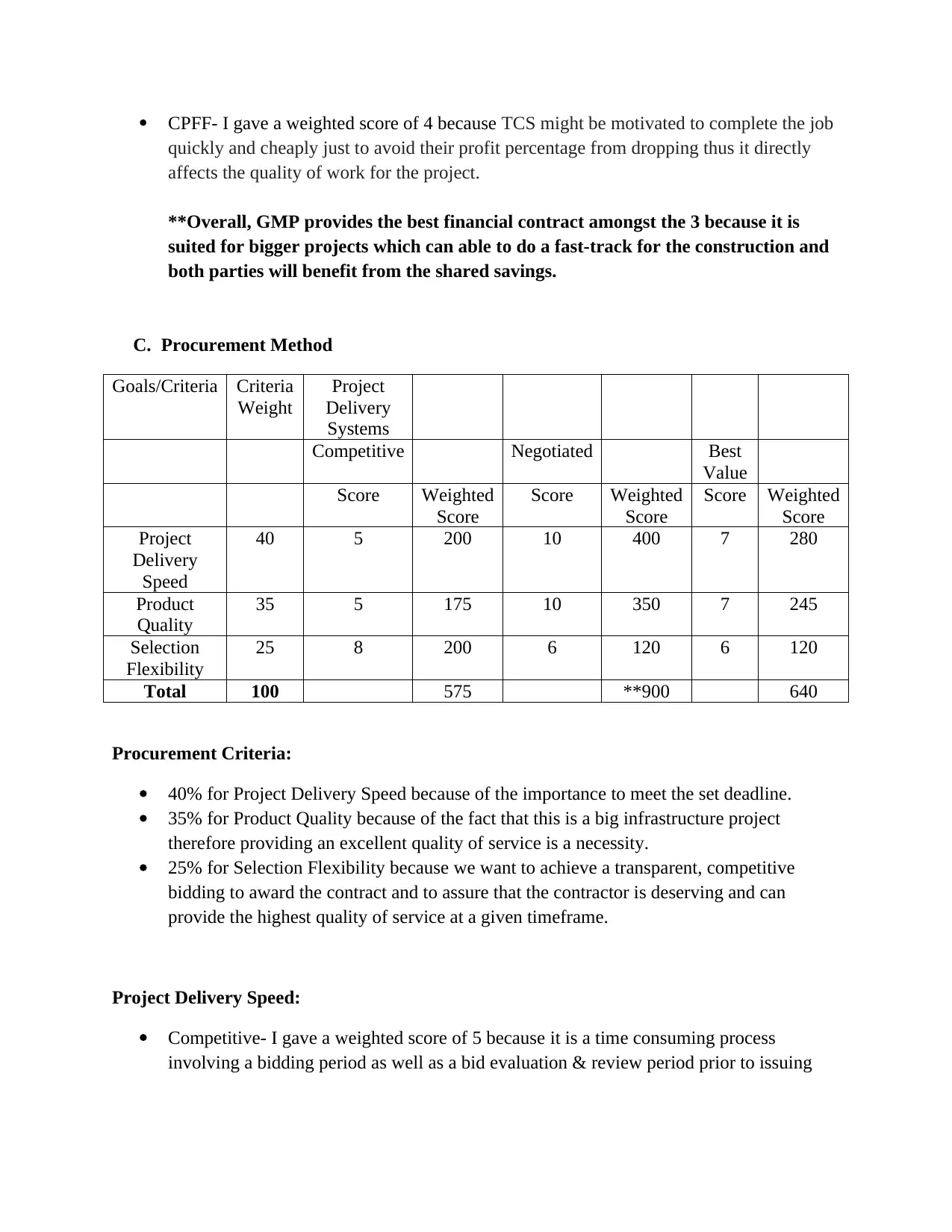
CPFF- I gave a weighted score of 4 because TCS might be motivated to complete the job
quickly and cheaply just to avoid their profit percentage from dropping thus it directly
affects the quality of work for the project.
**Overall, GMP provides the best financial contract amongst the 3 because it is
suited for bigger projects which can able to do a fast-track for the construction and
both parties will benefit from the shared savings.
C. Procurement Method
Goals/Criteria Criteria
Weight
Project
Delivery
Systems
Competitive Negotiated Best
Value
Score Weighted
Score
Score Weighted
Score
Score Weighted
Score
Project
Delivery
Speed
40 5 200 10 400 7 280
Product
Quality
35 5 175 10 350 7 245
Selection
Flexibility
25 8 200 6 120 6 120
Total 100 575 **900 640
Procurement Criteria:
40% for Project Delivery Speed because of the importance to meet the set deadline.
35% for Product Quality because of the fact that this is a big infrastructure project
therefore providing an excellent quality of service is a necessity.
25% for Selection Flexibility because we want to achieve a transparent, competitive
bidding to award the contract and to assure that the contractor is deserving and can
provide the highest quality of service at a given timeframe.
Project Delivery Speed:
Competitive- I gave a weighted score of 5 because it is a time consuming process
involving a bidding period as well as a bid evaluation & review period prior to issuing
quickly and cheaply just to avoid their profit percentage from dropping thus it directly
affects the quality of work for the project.
**Overall, GMP provides the best financial contract amongst the 3 because it is
suited for bigger projects which can able to do a fast-track for the construction and
both parties will benefit from the shared savings.
C. Procurement Method
Goals/Criteria Criteria
Weight
Project
Delivery
Systems
Competitive Negotiated Best
Value
Score Weighted
Score
Score Weighted
Score
Score Weighted
Score
Project
Delivery
Speed
40 5 200 10 400 7 280
Product
Quality
35 5 175 10 350 7 245
Selection
Flexibility
25 8 200 6 120 6 120
Total 100 575 **900 640
Procurement Criteria:
40% for Project Delivery Speed because of the importance to meet the set deadline.
35% for Product Quality because of the fact that this is a big infrastructure project
therefore providing an excellent quality of service is a necessity.
25% for Selection Flexibility because we want to achieve a transparent, competitive
bidding to award the contract and to assure that the contractor is deserving and can
provide the highest quality of service at a given timeframe.
Project Delivery Speed:
Competitive- I gave a weighted score of 5 because it is a time consuming process
involving a bidding period as well as a bid evaluation & review period prior to issuing
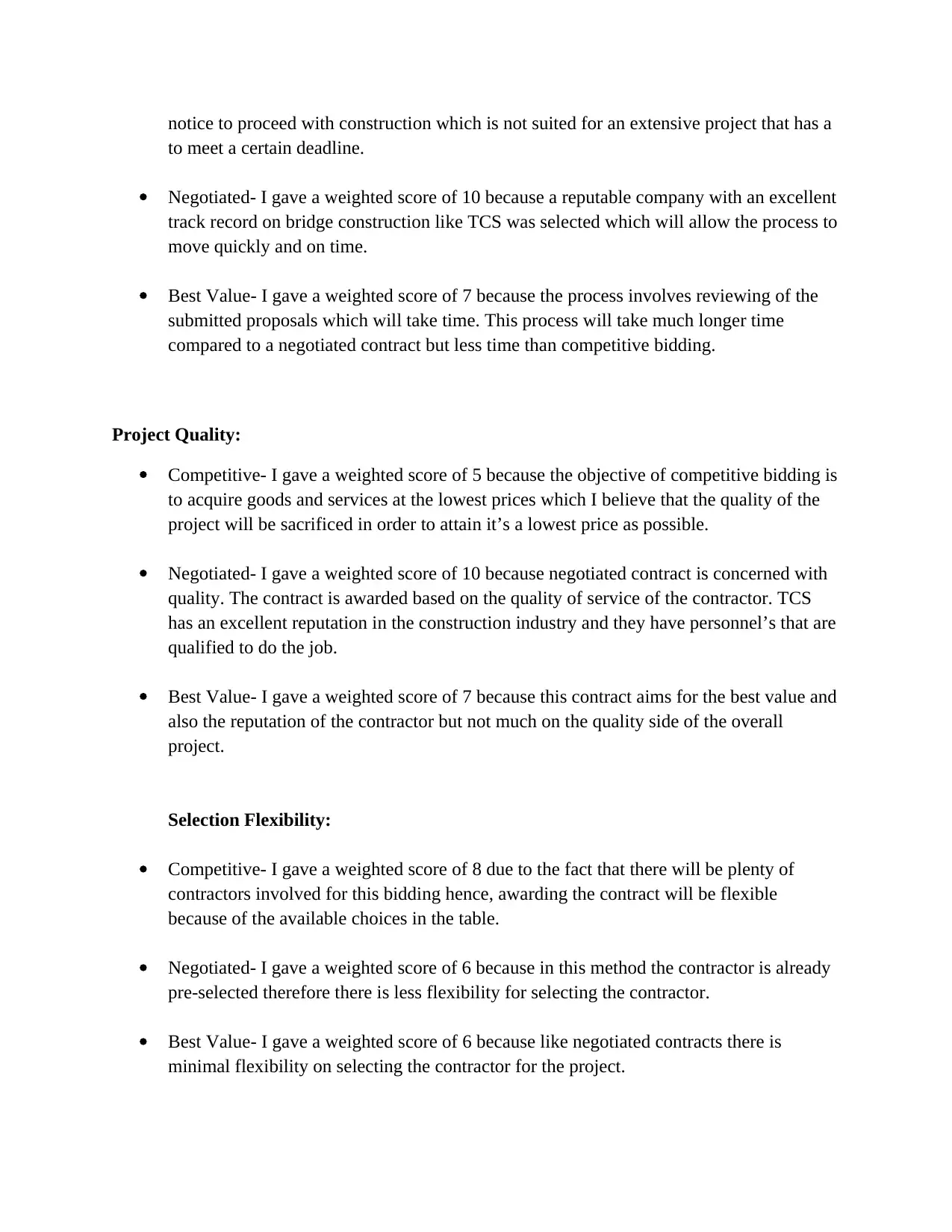
notice to proceed with construction which is not suited for an extensive project that has a
to meet a certain deadline.
Negotiated- I gave a weighted score of 10 because a reputable company with an excellent
track record on bridge construction like TCS was selected which will allow the process to
move quickly and on time.
Best Value- I gave a weighted score of 7 because the process involves reviewing of the
submitted proposals which will take time. This process will take much longer time
compared to a negotiated contract but less time than competitive bidding.
Project Quality:
Competitive- I gave a weighted score of 5 because the objective of competitive bidding is
to acquire goods and services at the lowest prices which I believe that the quality of the
project will be sacrificed in order to attain it’s a lowest price as possible.
Negotiated- I gave a weighted score of 10 because negotiated contract is concerned with
quality. The contract is awarded based on the quality of service of the contractor. TCS
has an excellent reputation in the construction industry and they have personnel’s that are
qualified to do the job.
Best Value- I gave a weighted score of 7 because this contract aims for the best value and
also the reputation of the contractor but not much on the quality side of the overall
project.
Selection Flexibility:
Competitive- I gave a weighted score of 8 due to the fact that there will be plenty of
contractors involved for this bidding hence, awarding the contract will be flexible
because of the available choices in the table.
Negotiated- I gave a weighted score of 6 because in this method the contractor is already
pre-selected therefore there is less flexibility for selecting the contractor.
Best Value- I gave a weighted score of 6 because like negotiated contracts there is
minimal flexibility on selecting the contractor for the project.
to meet a certain deadline.
Negotiated- I gave a weighted score of 10 because a reputable company with an excellent
track record on bridge construction like TCS was selected which will allow the process to
move quickly and on time.
Best Value- I gave a weighted score of 7 because the process involves reviewing of the
submitted proposals which will take time. This process will take much longer time
compared to a negotiated contract but less time than competitive bidding.
Project Quality:
Competitive- I gave a weighted score of 5 because the objective of competitive bidding is
to acquire goods and services at the lowest prices which I believe that the quality of the
project will be sacrificed in order to attain it’s a lowest price as possible.
Negotiated- I gave a weighted score of 10 because negotiated contract is concerned with
quality. The contract is awarded based on the quality of service of the contractor. TCS
has an excellent reputation in the construction industry and they have personnel’s that are
qualified to do the job.
Best Value- I gave a weighted score of 7 because this contract aims for the best value and
also the reputation of the contractor but not much on the quality side of the overall
project.
Selection Flexibility:
Competitive- I gave a weighted score of 8 due to the fact that there will be plenty of
contractors involved for this bidding hence, awarding the contract will be flexible
because of the available choices in the table.
Negotiated- I gave a weighted score of 6 because in this method the contractor is already
pre-selected therefore there is less flexibility for selecting the contractor.
Best Value- I gave a weighted score of 6 because like negotiated contracts there is
minimal flexibility on selecting the contractor for the project.
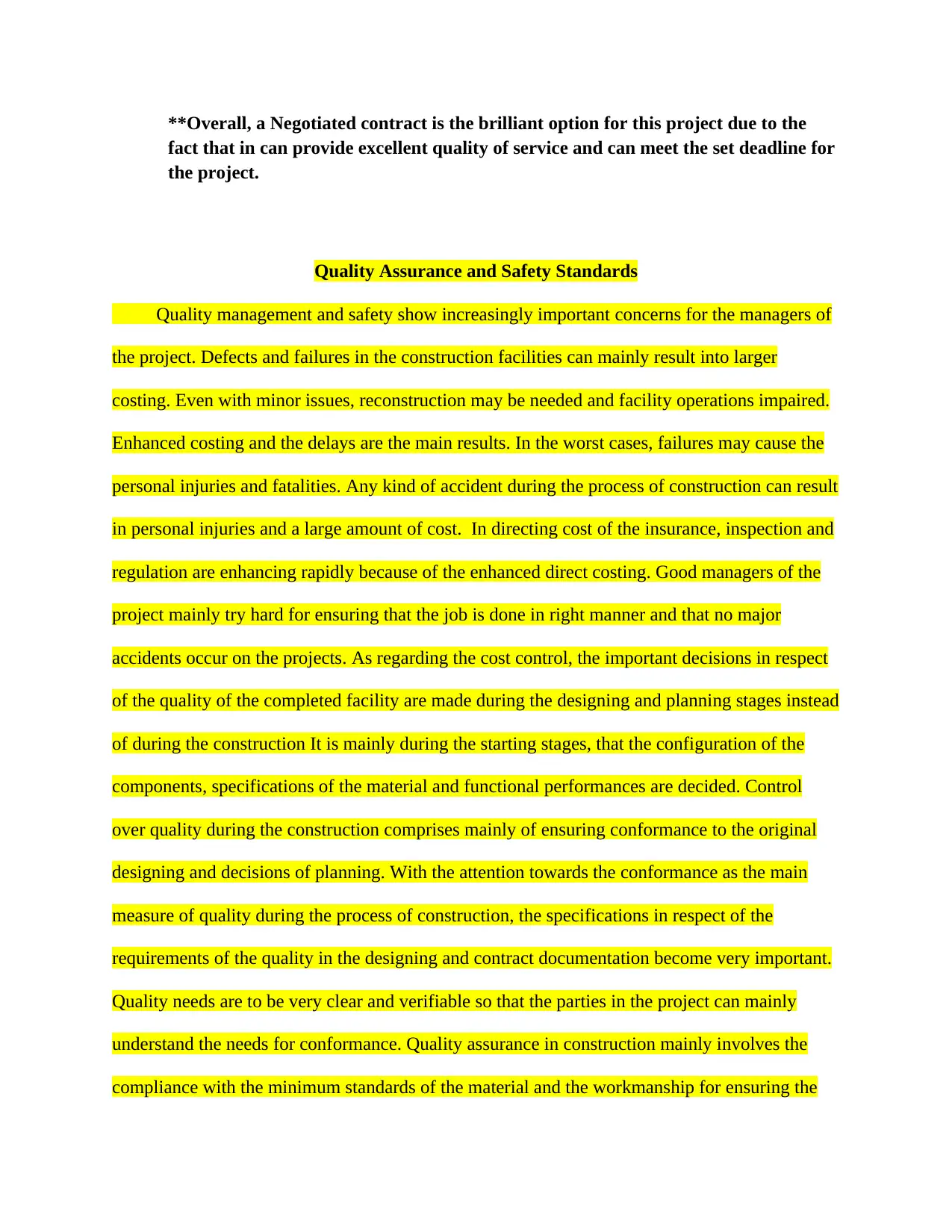
**Overall, a Negotiated contract is the brilliant option for this project due to the
fact that in can provide excellent quality of service and can meet the set deadline for
the project.
Quality Assurance and Safety Standards
Quality management and safety show increasingly important concerns for the managers of
the project. Defects and failures in the construction facilities can mainly result into larger
costing. Even with minor issues, reconstruction may be needed and facility operations impaired.
Enhanced costing and the delays are the main results. In the worst cases, failures may cause the
personal injuries and fatalities. Any kind of accident during the process of construction can result
in personal injuries and a large amount of cost. In directing cost of the insurance, inspection and
regulation are enhancing rapidly because of the enhanced direct costing. Good managers of the
project mainly try hard for ensuring that the job is done in right manner and that no major
accidents occur on the projects. As regarding the cost control, the important decisions in respect
of the quality of the completed facility are made during the designing and planning stages instead
of during the construction It is mainly during the starting stages, that the configuration of the
components, specifications of the material and functional performances are decided. Control
over quality during the construction comprises mainly of ensuring conformance to the original
designing and decisions of planning. With the attention towards the conformance as the main
measure of quality during the process of construction, the specifications in respect of the
requirements of the quality in the designing and contract documentation become very important.
Quality needs are to be very clear and verifiable so that the parties in the project can mainly
understand the needs for conformance. Quality assurance in construction mainly involves the
compliance with the minimum standards of the material and the workmanship for ensuring the
fact that in can provide excellent quality of service and can meet the set deadline for
the project.
Quality Assurance and Safety Standards
Quality management and safety show increasingly important concerns for the managers of
the project. Defects and failures in the construction facilities can mainly result into larger
costing. Even with minor issues, reconstruction may be needed and facility operations impaired.
Enhanced costing and the delays are the main results. In the worst cases, failures may cause the
personal injuries and fatalities. Any kind of accident during the process of construction can result
in personal injuries and a large amount of cost. In directing cost of the insurance, inspection and
regulation are enhancing rapidly because of the enhanced direct costing. Good managers of the
project mainly try hard for ensuring that the job is done in right manner and that no major
accidents occur on the projects. As regarding the cost control, the important decisions in respect
of the quality of the completed facility are made during the designing and planning stages instead
of during the construction It is mainly during the starting stages, that the configuration of the
components, specifications of the material and functional performances are decided. Control
over quality during the construction comprises mainly of ensuring conformance to the original
designing and decisions of planning. With the attention towards the conformance as the main
measure of quality during the process of construction, the specifications in respect of the
requirements of the quality in the designing and contract documentation become very important.
Quality needs are to be very clear and verifiable so that the parties in the project can mainly
understand the needs for conformance. Quality assurance in construction mainly involves the
compliance with the minimum standards of the material and the workmanship for ensuring the
Secure Best Marks with AI Grader
Need help grading? Try our AI Grader for instant feedback on your assignments.

performance of the facilities as per the design. The minimum standards are contained in the
specifications. For ensuring compliance, random samples and statistical methods should be used
as the basis for accepting or rejecting work completed and batches of materials.
Rejection of the batch is mainly based on non-conformance and violation of the
specifications of the design. Procedure for the quality assurance practices are illustrated below
(Pmbook, 2017):
An implicit assumption in such traditional quality proactive is the main notion of the
acceptable level of quality which is mainly allowed fraction of the defective items.
Materials obtained from the suppliers and the work done by the organization is mainly
inspected and passed if the estimated defects percentage is within the accepted level of
quality. Problems with the materials are mainly corrected after the delivery of the
product (Esub, 2017).
Total quality control is the main commitment and assurance towards quality expressed
in all the parts of the organization and also involves various kinds of elements. Other
elements comprise of extensive training for the personnel, responsibility sharing for
detecting the defects from the quality control inspectors to workers and continuously
managing equipment. Involvement of the workers in improved control of quality is
mainly formalized in the circles of quality in which the groups of the workers meet
regularly for making suggestions for the improvement of the quality. Suppliers are
needed to ensure zero defects in the goods which are delivered. Initially, all the
material from the supplier needs to be inspected and batches of goods with the
defective items are returned. Suppliers with better records can be mainly certified and
subjected to complete inspection.
specifications. For ensuring compliance, random samples and statistical methods should be used
as the basis for accepting or rejecting work completed and batches of materials.
Rejection of the batch is mainly based on non-conformance and violation of the
specifications of the design. Procedure for the quality assurance practices are illustrated below
(Pmbook, 2017):
An implicit assumption in such traditional quality proactive is the main notion of the
acceptable level of quality which is mainly allowed fraction of the defective items.
Materials obtained from the suppliers and the work done by the organization is mainly
inspected and passed if the estimated defects percentage is within the accepted level of
quality. Problems with the materials are mainly corrected after the delivery of the
product (Esub, 2017).
Total quality control is the main commitment and assurance towards quality expressed
in all the parts of the organization and also involves various kinds of elements. Other
elements comprise of extensive training for the personnel, responsibility sharing for
detecting the defects from the quality control inspectors to workers and continuously
managing equipment. Involvement of the workers in improved control of quality is
mainly formalized in the circles of quality in which the groups of the workers meet
regularly for making suggestions for the improvement of the quality. Suppliers are
needed to ensure zero defects in the goods which are delivered. Initially, all the
material from the supplier needs to be inspected and batches of goods with the
defective items are returned. Suppliers with better records can be mainly certified and
subjected to complete inspection.

With all the other costs associated with construction, it is a big mistake for the owners to
ignore the significant category of the costing like the injury and illness. While the contractors
may pay the premium to insurance companies, such kind of costing are mainly reflected in the
bidding prices or contracted amounts. Delay mainly caused by the injuries can create opportunity
costing to the owners. In the long run, the owners of the facilities need to pay all the judgments
and the insurance payments compensate for the losses and are mainly borne by the owners.
Various types of measures are currently available for improving the job site safety in the
construction. Several of the most important mainly occurs before the construction is undertaken.
Such acts include the designs, choices of the technologies and education. By mainly altering the
designing of the facilities, structures can be made safe and hazardous for construction. For
instance, parapets can be designed at appropriate heights for construction worker’s safety, rather
than at minimum height needed by building codes (Prgus, 2017).
Technology’s choices can be critical in the determination of the safety of the job site.
Safeguarding develops into the machinery can mainly notify the operators of the issues. for
instance, simple switches can mainly prevent the equipment from being the operative when the
protective shields are not much in place. With the availability of the onboard electronics. The
probabilities for the controllers of machine and monitor has mainly expanded for t equipment
and tools. Materials and the process choices also influence the construction of the safety. For
instance, substitution of the materials for the asbestos can reduce the prospects of the illness like
the asbestosis (Red Mountain Services, 2017).
Education of the workers and making them aware in proper procedures can have the direct
amount of impact on the safety. The realization of the larger costs which are involved in the
injuries of construction and illness offers considerable motivation for the awareness. Regular
ignore the significant category of the costing like the injury and illness. While the contractors
may pay the premium to insurance companies, such kind of costing are mainly reflected in the
bidding prices or contracted amounts. Delay mainly caused by the injuries can create opportunity
costing to the owners. In the long run, the owners of the facilities need to pay all the judgments
and the insurance payments compensate for the losses and are mainly borne by the owners.
Various types of measures are currently available for improving the job site safety in the
construction. Several of the most important mainly occurs before the construction is undertaken.
Such acts include the designs, choices of the technologies and education. By mainly altering the
designing of the facilities, structures can be made safe and hazardous for construction. For
instance, parapets can be designed at appropriate heights for construction worker’s safety, rather
than at minimum height needed by building codes (Prgus, 2017).
Technology’s choices can be critical in the determination of the safety of the job site.
Safeguarding develops into the machinery can mainly notify the operators of the issues. for
instance, simple switches can mainly prevent the equipment from being the operative when the
protective shields are not much in place. With the availability of the onboard electronics. The
probabilities for the controllers of machine and monitor has mainly expanded for t equipment
and tools. Materials and the process choices also influence the construction of the safety. For
instance, substitution of the materials for the asbestos can reduce the prospects of the illness like
the asbestosis (Red Mountain Services, 2017).
Education of the workers and making them aware in proper procedures can have the direct
amount of impact on the safety. The realization of the larger costs which are involved in the
injuries of construction and illness offers considerable motivation for the awareness. Regular
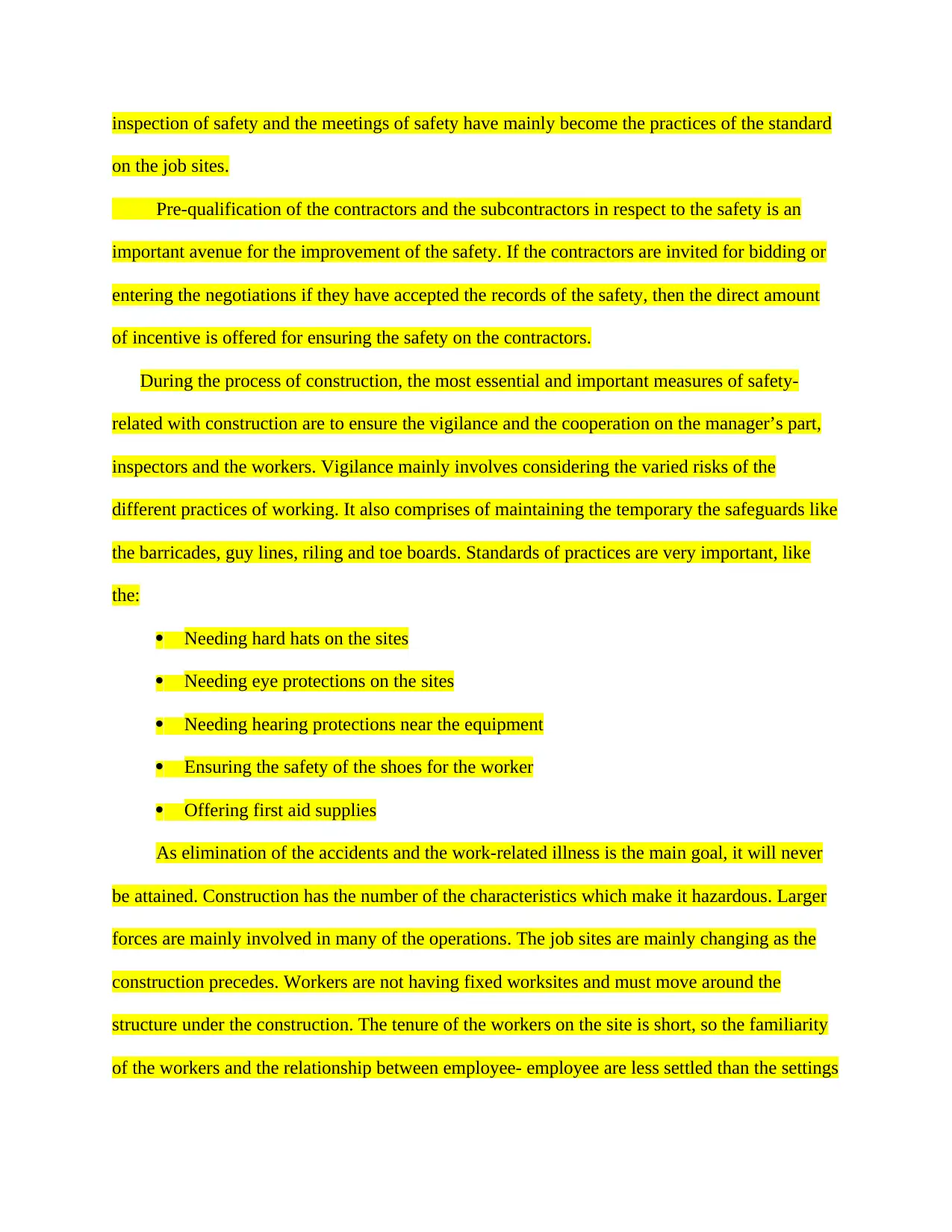
inspection of safety and the meetings of safety have mainly become the practices of the standard
on the job sites.
Pre-qualification of the contractors and the subcontractors in respect to the safety is an
important avenue for the improvement of the safety. If the contractors are invited for bidding or
entering the negotiations if they have accepted the records of the safety, then the direct amount
of incentive is offered for ensuring the safety on the contractors.
During the process of construction, the most essential and important measures of safety-
related with construction are to ensure the vigilance and the cooperation on the manager’s part,
inspectors and the workers. Vigilance mainly involves considering the varied risks of the
different practices of working. It also comprises of maintaining the temporary the safeguards like
the barricades, guy lines, riling and toe boards. Standards of practices are very important, like
the:
Needing hard hats on the sites
Needing eye protections on the sites
Needing hearing protections near the equipment
Ensuring the safety of the shoes for the worker
Offering first aid supplies
As elimination of the accidents and the work-related illness is the main goal, it will never
be attained. Construction has the number of the characteristics which make it hazardous. Larger
forces are mainly involved in many of the operations. The job sites are mainly changing as the
construction precedes. Workers are not having fixed worksites and must move around the
structure under the construction. The tenure of the workers on the site is short, so the familiarity
of the workers and the relationship between employee- employee are less settled than the settings
on the job sites.
Pre-qualification of the contractors and the subcontractors in respect to the safety is an
important avenue for the improvement of the safety. If the contractors are invited for bidding or
entering the negotiations if they have accepted the records of the safety, then the direct amount
of incentive is offered for ensuring the safety on the contractors.
During the process of construction, the most essential and important measures of safety-
related with construction are to ensure the vigilance and the cooperation on the manager’s part,
inspectors and the workers. Vigilance mainly involves considering the varied risks of the
different practices of working. It also comprises of maintaining the temporary the safeguards like
the barricades, guy lines, riling and toe boards. Standards of practices are very important, like
the:
Needing hard hats on the sites
Needing eye protections on the sites
Needing hearing protections near the equipment
Ensuring the safety of the shoes for the worker
Offering first aid supplies
As elimination of the accidents and the work-related illness is the main goal, it will never
be attained. Construction has the number of the characteristics which make it hazardous. Larger
forces are mainly involved in many of the operations. The job sites are mainly changing as the
construction precedes. Workers are not having fixed worksites and must move around the
structure under the construction. The tenure of the workers on the site is short, so the familiarity
of the workers and the relationship between employee- employee are less settled than the settings
Paraphrase This Document
Need a fresh take? Get an instant paraphrase of this document with our AI Paraphraser
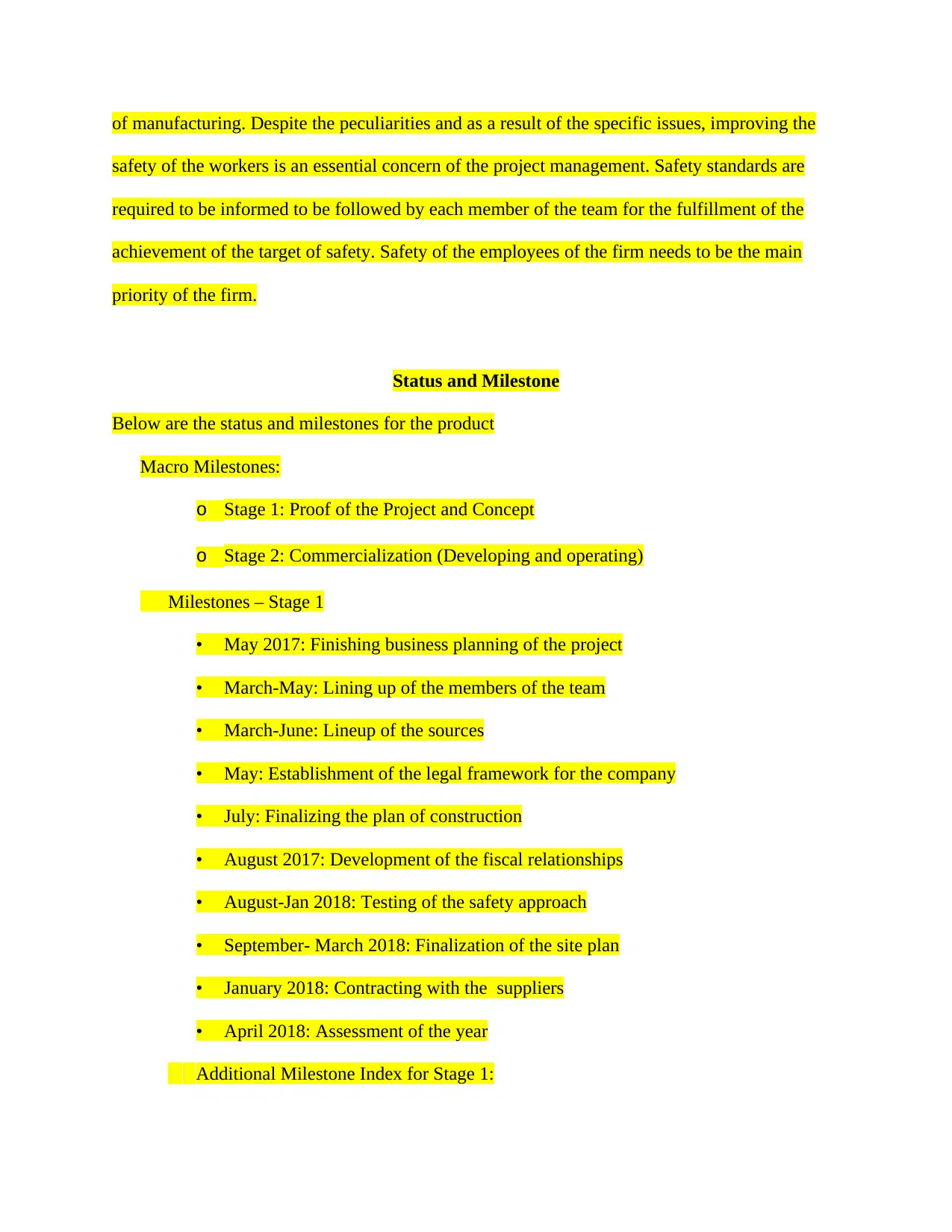
of manufacturing. Despite the peculiarities and as a result of the specific issues, improving the
safety of the workers is an essential concern of the project management. Safety standards are
required to be informed to be followed by each member of the team for the fulfillment of the
achievement of the target of safety. Safety of the employees of the firm needs to be the main
priority of the firm.
Status and Milestone
Below are the status and milestones for the product
Macro Milestones:
o Stage 1: Proof of the Project and Concept
o Stage 2: Commercialization (Developing and operating)
Milestones – Stage 1
• May 2017: Finishing business planning of the project
• March-May: Lining up of the members of the team
• March-June: Lineup of the sources
• May: Establishment of the legal framework for the company
• July: Finalizing the plan of construction
• August 2017: Development of the fiscal relationships
• August-Jan 2018: Testing of the safety approach
• September- March 2018: Finalization of the site plan
• January 2018: Contracting with the suppliers
• April 2018: Assessment of the year
Additional Milestone Index for Stage 1:
safety of the workers is an essential concern of the project management. Safety standards are
required to be informed to be followed by each member of the team for the fulfillment of the
achievement of the target of safety. Safety of the employees of the firm needs to be the main
priority of the firm.
Status and Milestone
Below are the status and milestones for the product
Macro Milestones:
o Stage 1: Proof of the Project and Concept
o Stage 2: Commercialization (Developing and operating)
Milestones – Stage 1
• May 2017: Finishing business planning of the project
• March-May: Lining up of the members of the team
• March-June: Lineup of the sources
• May: Establishment of the legal framework for the company
• July: Finalizing the plan of construction
• August 2017: Development of the fiscal relationships
• August-Jan 2018: Testing of the safety approach
• September- March 2018: Finalization of the site plan
• January 2018: Contracting with the suppliers
• April 2018: Assessment of the year
Additional Milestone Index for Stage 1:
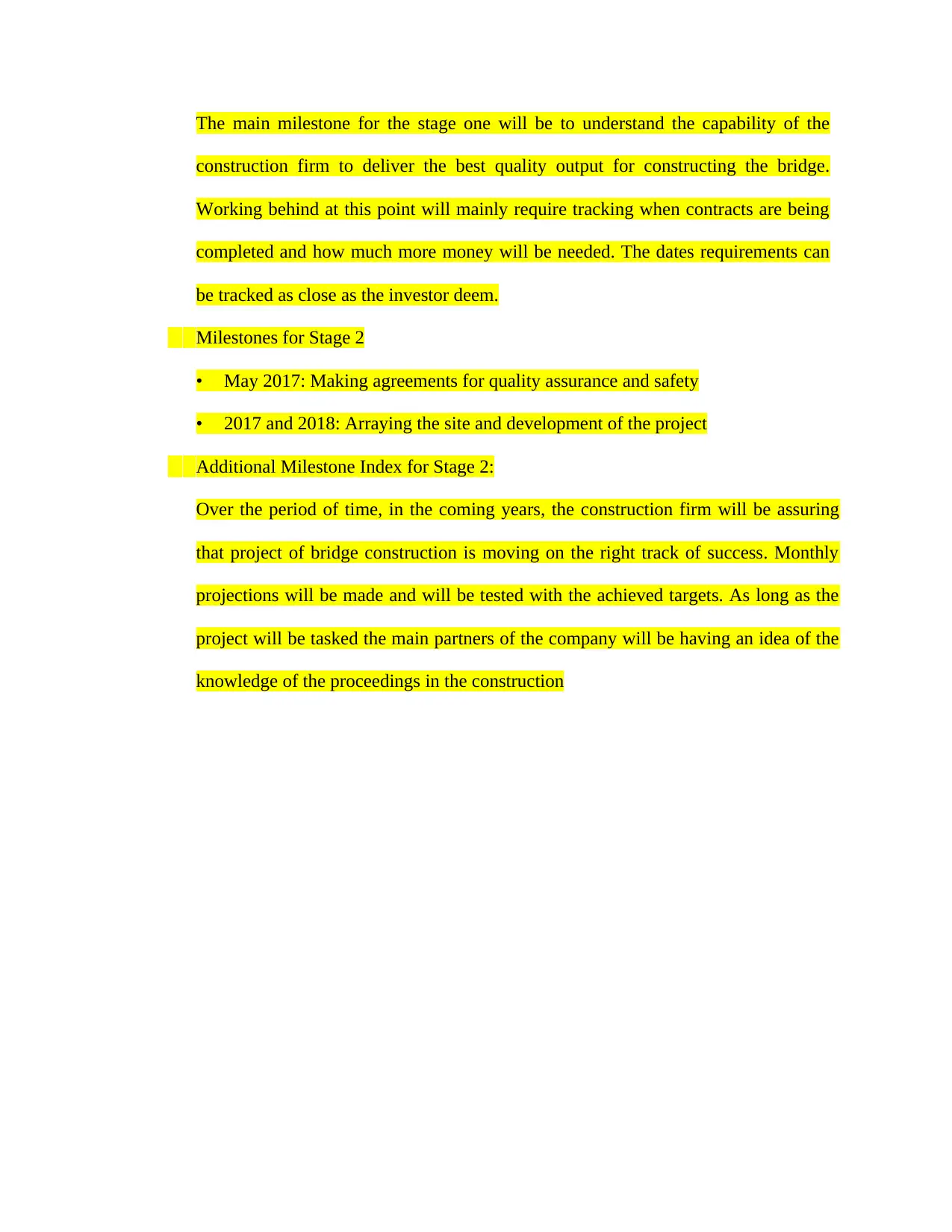
The main milestone for the stage one will be to understand the capability of the
construction firm to deliver the best quality output for constructing the bridge.
Working behind at this point will mainly require tracking when contracts are being
completed and how much more money will be needed. The dates requirements can
be tracked as close as the investor deem.
Milestones for Stage 2
• May 2017: Making agreements for quality assurance and safety
• 2017 and 2018: Arraying the site and development of the project
Additional Milestone Index for Stage 2:
Over the period of time, in the coming years, the construction firm will be assuring
that project of bridge construction is moving on the right track of success. Monthly
projections will be made and will be tested with the achieved targets. As long as the
project will be tasked the main partners of the company will be having an idea of the
knowledge of the proceedings in the construction
construction firm to deliver the best quality output for constructing the bridge.
Working behind at this point will mainly require tracking when contracts are being
completed and how much more money will be needed. The dates requirements can
be tracked as close as the investor deem.
Milestones for Stage 2
• May 2017: Making agreements for quality assurance and safety
• 2017 and 2018: Arraying the site and development of the project
Additional Milestone Index for Stage 2:
Over the period of time, in the coming years, the construction firm will be assuring
that project of bridge construction is moving on the right track of success. Monthly
projections will be made and will be tested with the achieved targets. As long as the
project will be tasked the main partners of the company will be having an idea of the
knowledge of the proceedings in the construction
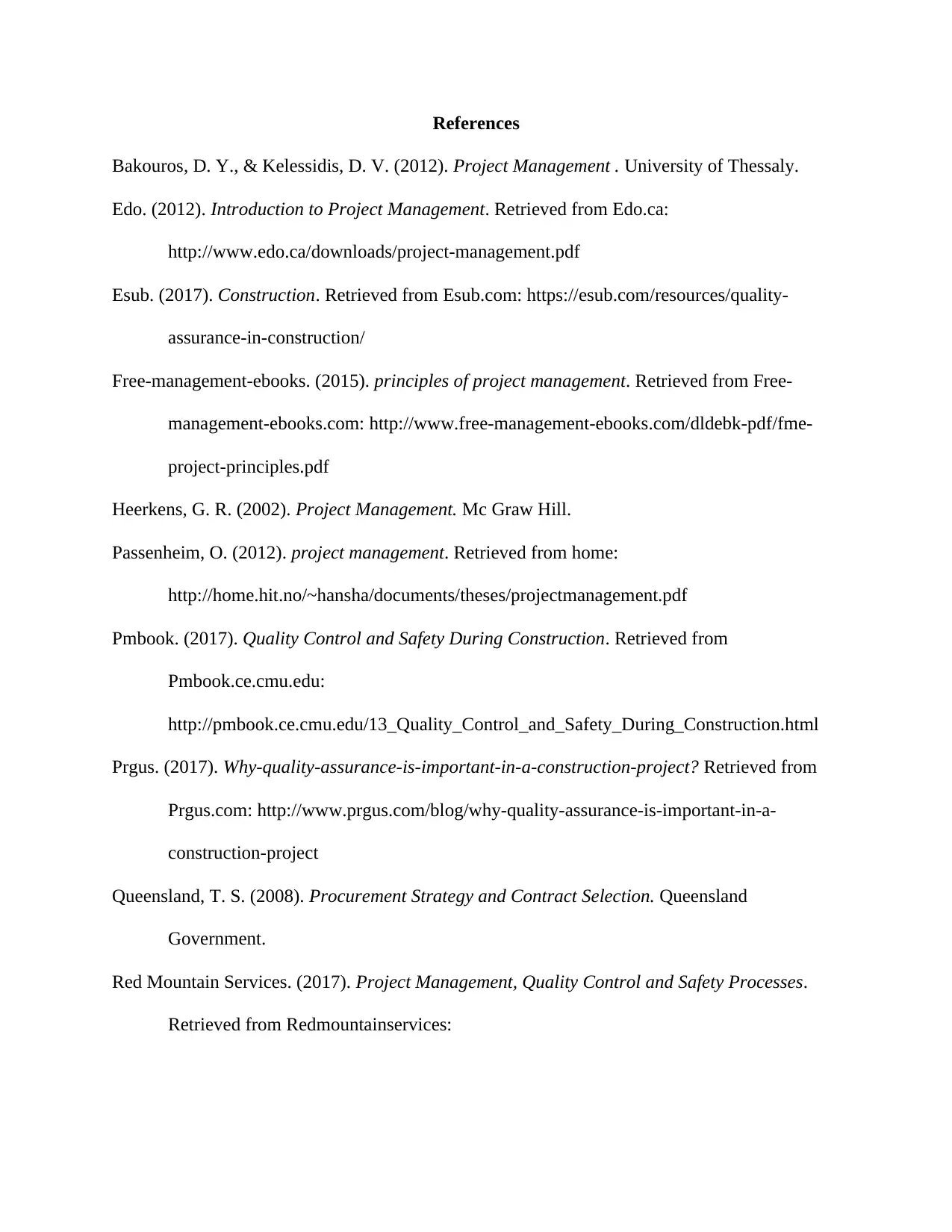
References
Bakouros, D. Y., & Kelessidis, D. V. (2012). Project Management . University of Thessaly.
Edo. (2012). Introduction to Project Management. Retrieved from Edo.ca:
http://www.edo.ca/downloads/project-management.pdf
Esub. (2017). Construction. Retrieved from Esub.com: https://esub.com/resources/quality-
assurance-in-construction/
Free-management-ebooks. (2015). principles of project management. Retrieved from Free-
management-ebooks.com: http://www.free-management-ebooks.com/dldebk-pdf/fme-
project-principles.pdf
Heerkens, G. R. (2002). Project Management. Mc Graw Hill.
Passenheim, O. (2012). project management. Retrieved from home:
http://home.hit.no/~hansha/documents/theses/projectmanagement.pdf
Pmbook. (2017). Quality Control and Safety During Construction. Retrieved from
Pmbook.ce.cmu.edu:
http://pmbook.ce.cmu.edu/13_Quality_Control_and_Safety_During_Construction.html
Prgus. (2017). Why-quality-assurance-is-important-in-a-construction-project? Retrieved from
Prgus.com: http://www.prgus.com/blog/why-quality-assurance-is-important-in-a-
construction-project
Queensland, T. S. (2008). Procurement Strategy and Contract Selection. Queensland
Government.
Red Mountain Services. (2017). Project Management, Quality Control and Safety Processes.
Retrieved from Redmountainservices:
Bakouros, D. Y., & Kelessidis, D. V. (2012). Project Management . University of Thessaly.
Edo. (2012). Introduction to Project Management. Retrieved from Edo.ca:
http://www.edo.ca/downloads/project-management.pdf
Esub. (2017). Construction. Retrieved from Esub.com: https://esub.com/resources/quality-
assurance-in-construction/
Free-management-ebooks. (2015). principles of project management. Retrieved from Free-
management-ebooks.com: http://www.free-management-ebooks.com/dldebk-pdf/fme-
project-principles.pdf
Heerkens, G. R. (2002). Project Management. Mc Graw Hill.
Passenheim, O. (2012). project management. Retrieved from home:
http://home.hit.no/~hansha/documents/theses/projectmanagement.pdf
Pmbook. (2017). Quality Control and Safety During Construction. Retrieved from
Pmbook.ce.cmu.edu:
http://pmbook.ce.cmu.edu/13_Quality_Control_and_Safety_During_Construction.html
Prgus. (2017). Why-quality-assurance-is-important-in-a-construction-project? Retrieved from
Prgus.com: http://www.prgus.com/blog/why-quality-assurance-is-important-in-a-
construction-project
Queensland, T. S. (2008). Procurement Strategy and Contract Selection. Queensland
Government.
Red Mountain Services. (2017). Project Management, Quality Control and Safety Processes.
Retrieved from Redmountainservices:
Secure Best Marks with AI Grader
Need help grading? Try our AI Grader for instant feedback on your assignments.

https://www.redmountainservices.com/services/construction/project-management-
quality-control-and-safety
UC Davis. (2013). Introduction to Project Management:Principles, Techniques and Tools. UC
Davis.
usbr. (2013). An Introduction to Project Management. Retrieved from usbr:
https://www.usbr.gov/excellence/Finals/FinalIntroPM.pdf
quality-control-and-safety
UC Davis. (2013). Introduction to Project Management:Principles, Techniques and Tools. UC
Davis.
usbr. (2013). An Introduction to Project Management. Retrieved from usbr:
https://www.usbr.gov/excellence/Finals/FinalIntroPM.pdf
1 out of 17
Related Documents
Your All-in-One AI-Powered Toolkit for Academic Success.
+13062052269
info@desklib.com
Available 24*7 on WhatsApp / Email
![[object Object]](/_next/static/media/star-bottom.7253800d.svg)
Unlock your academic potential
© 2024 | Zucol Services PVT LTD | All rights reserved.





